|
|
Post by koloagirl on Mar 17, 2011 21:31:00 GMT
 Aloha from Kaua'i! Well, after a busy day yesterday doing a tour at the Kaua'i Museum for a large group from the "Elderhostel" program (they were great, and really interested in the history of the island - which is a big help when you are trying to give a tour and talk about history!!)....today I'm pretty much at home until I have hula practice this afternoon - so I'll try to answer some questions and post some pictures...... In regards to the taro and how it is cooked - this is a picture of the "root" or "corm" of the taro (or kalo as it is also known) that is cut off and cooked before pounding it into poi: 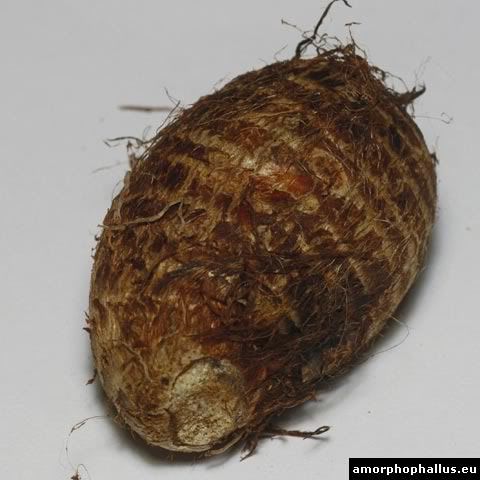 I've never heard of the "amadumbe" - but maybe it is a close cousin? As for the hala - here is a picture of the fruit from the hala (or pandanus) tree as it looks before it is taken apart: 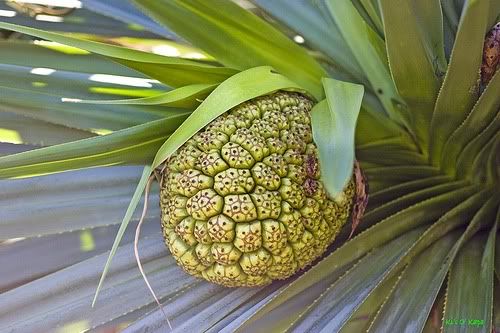 This is a picture of what the "inside" looks like - you can see the individual "keys" of the fruit and how the color is vibrant (some are even bright red inside): 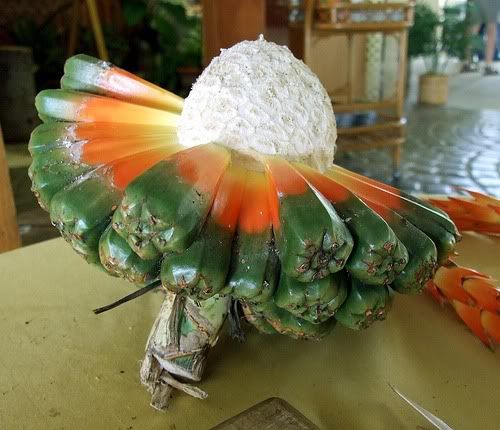 And this is a gentleman who is working with the keys of the hala to make leis like the ones that I had in an earlier post: 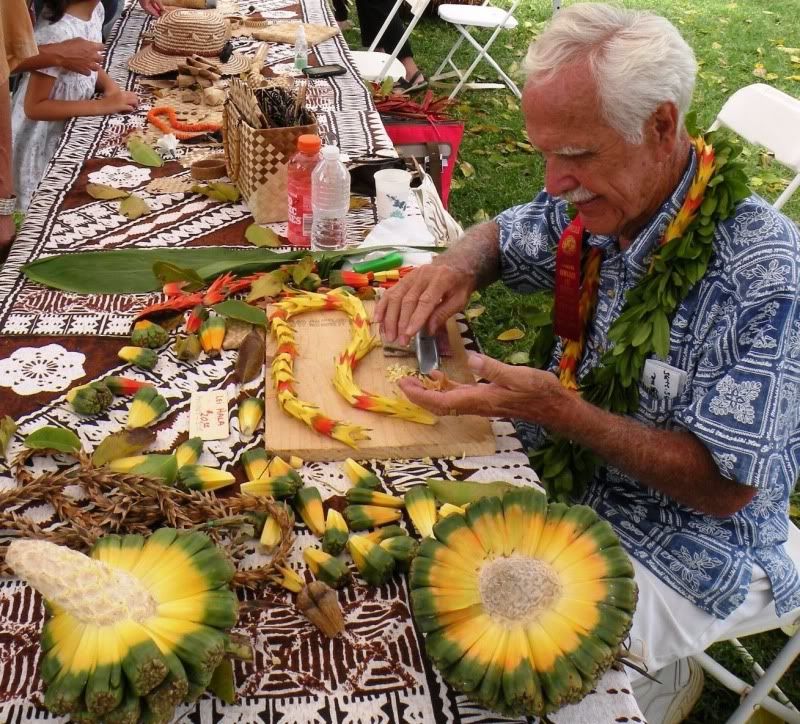 A lot of work and preparation - and the leis do indeed almost look "fake" as they are shiny and bright colored - they can last a long while also if stored properly - most common leis that people see from Hawai'i are a one or two day lasting lei - the idea of a lei is the "giving" of it and not to have it last forever - it is the whole idea of the thought and care of giving a lei that matters. I do have to say that we see visitors here walking around with obviously dead flowers hanging on a string that were only meant for a one day wearing - but you know - each to their own, right? lol I'll end this post and start another one now - I'm just getting used to this format and don't want it to get too repetitious - I obviously love talking about the history of the islands and my passion is hula - so ask away if questions arise and I'll do my best to answer them.....  Malama Pono, Janet
|
|
|
|
Post by Deleted on Mar 17, 2011 21:35:33 GMT
Oh my god, the hala is simply amazing inside (and out)! Is it edible or just decorative?
|
|
|
|
Post by koloagirl on Mar 17, 2011 22:18:06 GMT
Aloha from Kaua'i! I'm trying to answer the questions that were posed earlier, and I'll do my best! "Koloagirl, you said that on the island of Ni'ihau, all of the people are native Hawaiin. Are there issues about the native population and its culture being diluted out of existence by all the waves of immigrants there over the centuries? " Ni'ihau was actually "purchased" for $10,000 in 1864 from King Kamehameha IV by the Sinclair family, who passed it onto her descendants - the Robinsons - who still own the island today. As far as the people of Ni'ihau - there were approx. 350 Native Hawaiians (kanaka ma'oli) living there at the time of the purchase - these original families worked the "ranch" on the island for the Robinsons (which was shut down in 1999) and in 1915 Aubrey Robinson closed the island to most visitors. Even relatives of the inhabitants could visit only by special permission. This continues to this day. Right now there are about 130 people living on Ni'ihau - all of them are descendants of the original families from Ni'ihau - there are about 13 families whose names are instantly recognizable as being "Ni'ihau" names - it is a very small community with only one town and very religious as well. Pretty much all of the people living there are related to one another. Almost everyone is 100% Native Hawaiian and 'Olelo Hawai'i (Hawaiian language) is the first language spoken by people from Ni'ihau - unlike everyplace else in the state - where Hawaiian language is now being taught in Immersion programs, but not widely spoken by the people here. I have taken 2 years of an immersion program in Hawaiian language and I will tell you - it is a very difficult language indeed!!! All residents on Ni'ihau live rent-free, and meat is free. There are no telephones and only a couple of jeeps and ATV's. The residents are not allowed to own radios, televisions or mobile phones and visitors are not allowed to bring them to the island, even for personal use. This is a picture of a graduation ceremony I was invited to for students from the Charter School here on Kaua'i that is for the children of Ni'ihau - I was really honored to be invited to this as it isn't something that many "outsiders" get to participate in - there were only 4 students in this class and one of them was the daughter of a good friend of mine (who is a lei maker of the shell leis from Ni'hau)....here are a few pictures from this amazing event: This is a picture of my friend and her husband presenting their daughter with a a lei po'o (head lei) of Ni'ihau shells as well as multi-strands of lei (these just to give you an idea, probably cost in excess of $30,000 each if you were to buy them)....this is very special and is done in a ceremony with the family of each graduating student - note the special "kihei" (cloak) that is worn by the students as well: 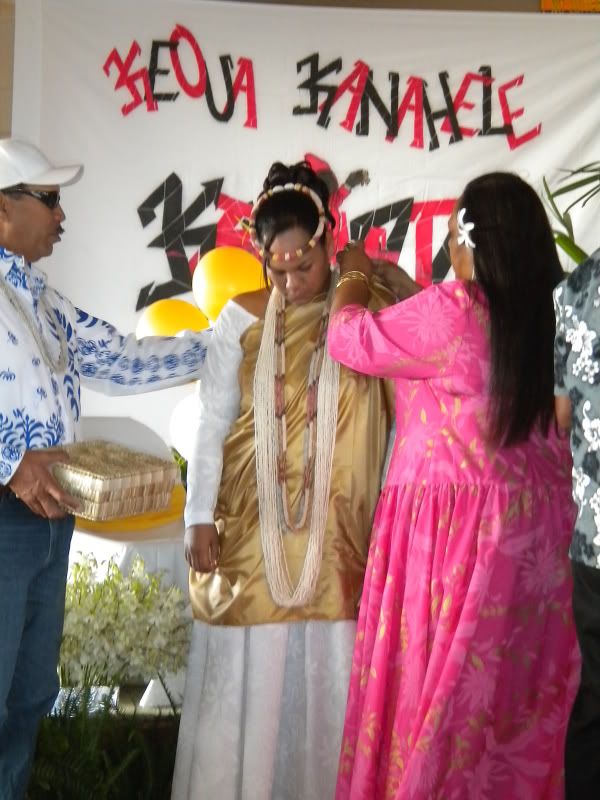 A picture of U'i - my friend's daughter - after the lei giving ceremony (by the way, all the spoken dialogue given at both the ceremony of graduation as well as this part - were in Hawaiian)  This is a picture of all 4 graduates after they have been given their diploma as well as the lei:  My friend - Ehu Kanahele - who is one of the best known lei makers of Ni'ihau shell lei in the islands - 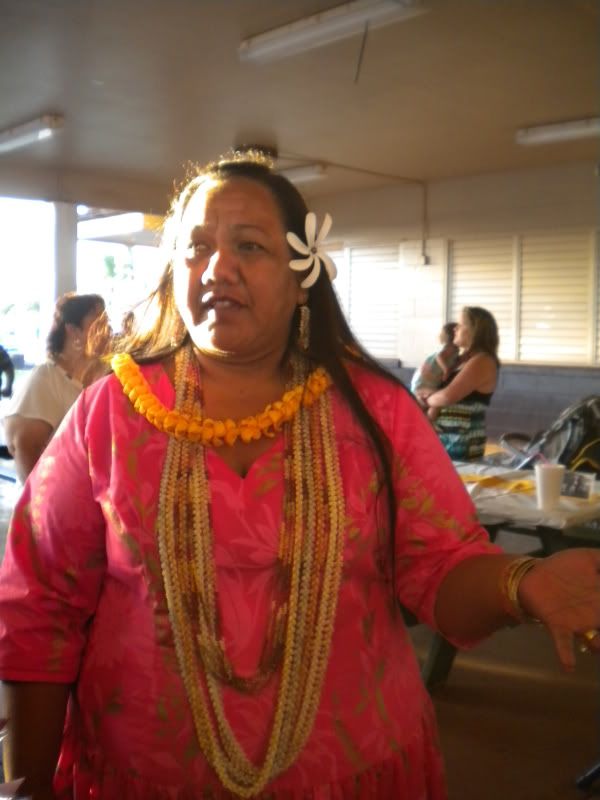 This doesn't even give you an idea of the huge lu'au that was done by friends and family (they prepared all the food for everyone) for the event - it was held in a tent - and there was every type of Hawaiian food you could imagine - the concept that Hawaiians eat until they are tired, not until they are full - well, it certainly applied to me here!! 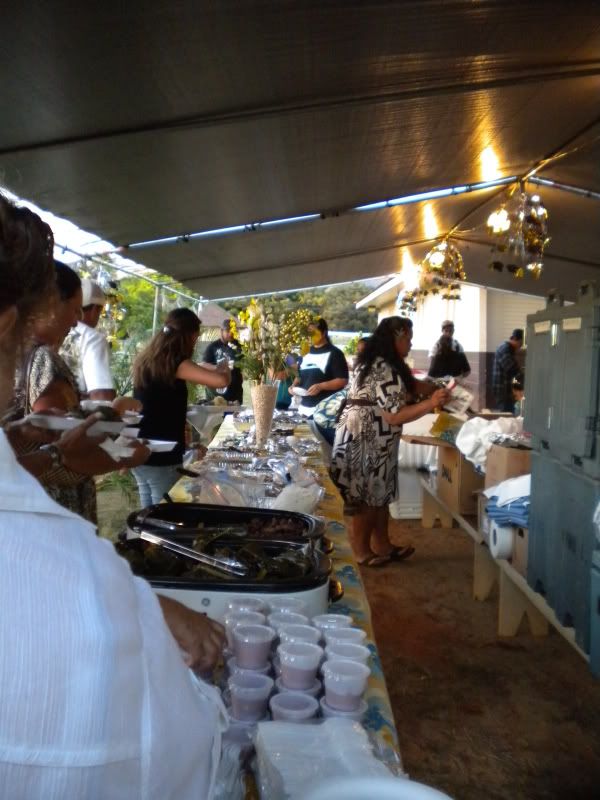 And afterwards - there were two very famous Hawaiian musicians flown in from Honolulu who played music well into the night - almost everyone got up and did hula - and this is a picture of U'i - whose very special lei was spectacular - I've really no idea what it was made of - I forgot to ask, but it was something I've never seen before!! Such a beautiful girl and in Hawaiian tradition - she calls me "Auntie Janet" (close friends who are older than you are usually called "Auntie" or "Uncle" here).... 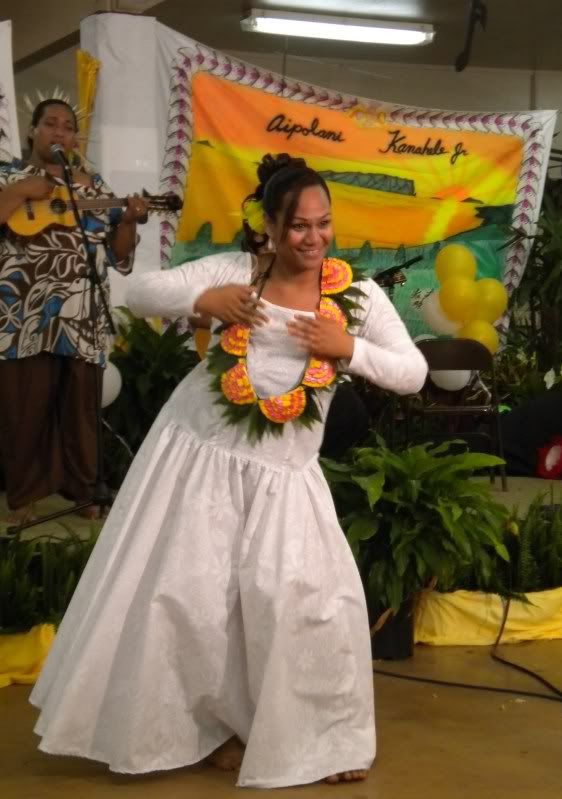 That was truly the most amazing and special event that I've ever been invited to here on Kaua'i - it was such a honor to attend this and by being friends with people from Ni'ihau (I'm lucky enough to know a few folks from there) - you learn so very much about the Hawaiian culture - since it hasn't been diluted much on Ni'ihau really. Malama Pono, Janet |
|
|
|
Post by koloagirl on Mar 17, 2011 23:43:07 GMT
 Aloha from Kaua'i! "Kerouac" - in regards to your question about the hala fruit - it is not edible. However the tree itself has many uses - the leaves are dried and turned into a material called "lauhala" that is woven into mats, hats, fans, etc, etc. and is a real art....the keys that you see being made into lei used to be dried and the "fuzzy" end of it was used as a paint brush by the ancient Hawaiians.  Malama Pono, Janet
|
|
|
|
Post by bixaorellana on Mar 18, 2011 3:57:17 GMT
Well, Janet, this is outstanding! Your friend's daughter is indeed beautiful. I love the stately picture of her after the lei giving ceremony, but the one with her dancing with that dazzling smile is just gorgeous.
Thank you for the excellent answers, some of which lead to more questions, if you don't mind.
Do residents of Ni'ihau who don't wish to live under those rules simply leave there? Does the Robinson family administer the island, rather than a civil authority? Whom do they marry to prevent too much inter-marriage? You said they're very religious. Is their religion one indigenous to the area, or Christianity? And one last question about Ni'hau, please. You write that the graduation ceremony was "for students from the Charter School here on Kaua'i that is for the children of Ni'ihau". Does that mean that Ni'ihau children do not attend schools with children from elsewhere?
Your photographs are really wonderful. Looking at them reminded me of one scrap of information I have about Hawai'i. Isn't there a rich textile tradition there? I noticed the shirt of the man making the hala lei and the really beautiful table coverings. The shirt U'i's father is wearing and that of the musician behind her are really exceptional as well. Is it a type of batik.
I believe Hawai'i also has a specific and beautiful kind of quilting, doesn't it?
Hope you don't mind all the questions. This is a fascinating topic and you present it so well.
Thank you!
|
|
|
|
Post by tod2 on Mar 18, 2011 12:45:03 GMT
Koloagirl, the photos are fab and let me peek into a culture I've only seen in the movies! What a wonderful place Kaua'i is  Thanks for the photo of the taro corm is definitely an amadumbi! Here they are in one of our supermarkets - We call these 'mdumbi - they are very starchy and the flesh is a grey colour.  Do you agree they are one and the same??? |
|
|
|
Post by auntieannie on Mar 18, 2011 14:02:32 GMT
oooh, what a fantastic thread!
Koloagirl, I must agree with the general consensus. I have learnt so much about Hawai'i from this thread alone. Thank you from the bottom of my heart. I am looking forward to learning more.
I have no specific question at the moment, but will come back to you at some point.
take care!
|
|
|
|
Post by frenchmystiquetour on Mar 18, 2011 16:39:20 GMT
Really great post koloagirl. My questions are the same as Bixa's so I'll wait for your answers too. When you said those shell necklaces are worth $30,000 I was only a bit surprised. In New England the shell necklaces were called wampum and they were both ceremonial and used as currency. As a matter of fact, the very first English settlers(invaders) also used wampum as currency. I'd like to hear about how the shell necklaces are made, who makes them and how long it takes to make one. Maybe you've got a close up picture too so we can see some of the fine detail of these precious items.
|
|
|
|
Post by bjd on Mar 18, 2011 17:24:39 GMT
To add to Bixa's and FMT's questions, the fact that there are few cars, no radios or TVs -- is that imposed by the Sinclair family, or is it to do with the original peoples' religion -- like Amish or some traditionalist group?
|
|
|
|
Post by koloagirl on Mar 18, 2011 23:27:29 GMT
 Aloha from Kaua'i! Mahalo to you guys for all your great questions and responses to my pictures - I love my "adopted" home and the host culture that we are all lucky enough to benefit from by living here - for sure! ;D Okay - questions - hopefully these answers will be articulate enough to explain about Ni'ihau island and the residents, etc.: People that live on Ni'ihau work for the Robinson family - in one capacity or another. They have something called "Ni'ihau Safari's Inc." that brings big money hunters to the island via private helicopter to hunt feral boars, sheep that are damaging the environment there - while I am a big animal lover and definitely anti-hunter, this is something that is apparently very popular because of the mystique of Ni'ihau and the uniqueness of the animals that are hunted (the pigs were brought by the first Polynesian voyagers and the sheep were brought over by the Sinclair family after they bought the island). The other main form of income (approx. 80%) comes from a small Navy installation atop 1,300-foot-high cliffs. Remote-controlled tracking devices are used for testing and training with Kaua'i's Pacific Missile Range Facility. Modern missile defense tests are conducted at the site for the U.S. and its allies. The installation brings in millions of dollars a year, and provides the island with a stable economic base without the complexity of tourism or industrial development The island of Ni'ihau is part of the County of Kaua'i, and so is under the jurisdiction of the County Government here on Kaua'i - As far as inter-marrying....there were about 13 or 14 original families that lived on Ni'ihau - people from Ni'ihau still primarily marry other ohana (families) from Ni'ihau - while there are a few exceptions obviously - the majority of folks still are all inter-related. And I have to say that there is a distinct "look" about some Ni'ihau ohana - their facial features are similar - I may see someone at the movies for instance that I can't place their name, but I know they are a Kanahele family member simply by looking at them. It doesn't appear to have been a problem and obviously many of the family members from Ni'ihau do move off-island - most to the Western Side of Kaua'i and many do marry outside the Ni'ihau families - but they are the exceptions in my experience at least. Now for more pictures - the "Lei Pupu O Ni'ihau" aka Ni'ihau Shell Leis are highly prized - they are tiny, tiny shells that are gathered from various beaches on Ni'ihau by the women (different shells on different beaches, different times of the year, etc. - my friend Ehu was showing me a lei for instance that took 10 years to just gather the shells for the lei - because they only washed up at a certain time of year)......painstakingly sorted who then put tiny pukas (holes) in the shells and string them in very intricate types of lei - from the basic pikake style to the more modern helconia and crown flower patterns (these latter types mimick the helconia flower and the crown flower) - as well as many other types. Pictures of these lei: Just to give you an idea of how small they are individually:  A selection of various types and stringing of lei:  A picture of my best friend and I - she is wearing 3 strands of a pikake style lei and also a 3 strand multi-shell type lei of mine (she is a hula teacher and a recording artist as well, so she frequently borrows my lei to mix with hers to make it look fuller in pictures and for big events - what are best friends for? lol) - 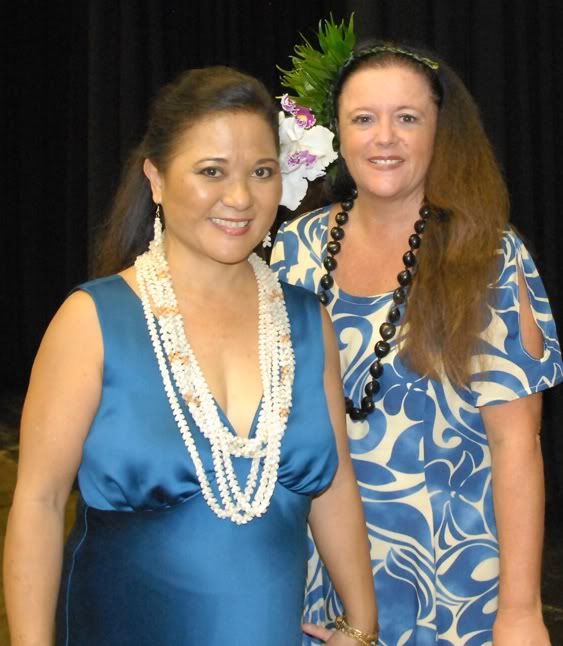 The matriarch of the Kanahele ohana (family) and of most of the Ni'ihau families - Mama Ane (pronounced Ah-Ney) Kanahele - my friend Ehu's mother - she is a reknowned lei maker as well as singer and hula teacher also:  The religion of the Ni'ihau people is very strong, they are strong Protestants and their lives in large part are based around pule (prayer) and services at the pule hale (church, literally in Hawaiian prayer house).....and while both Catholicism and Mormonism had been unsuccessfully introduced to the island over the years - just about every person from Ni'ihau is Protestant (I do know a very few people who moved to Kaua'i and became Mormons however). The school system on Ni'ihau is a little complicated - there is one school here on Kaua'i for the children of Ni'ihau (since there are so many families who own homes here on the West Side as well as on Ni'ihau) - Ni'ihau School is near the village of Puuwai is actually on the Island of Ni'ihau and...enrollment at the school fluctuates as children travel to and from Kaua'i for several weeks at a time. There is also one school here on Kaua'i - "Ke Kula Ni'ihau O Kekeha School" which teaches Ni'ihau children from elementary school thru high school (this is the charter school whose graduation I attended). Close-up of a lei made of the very rare "hot pink" shells called Kahelelani: 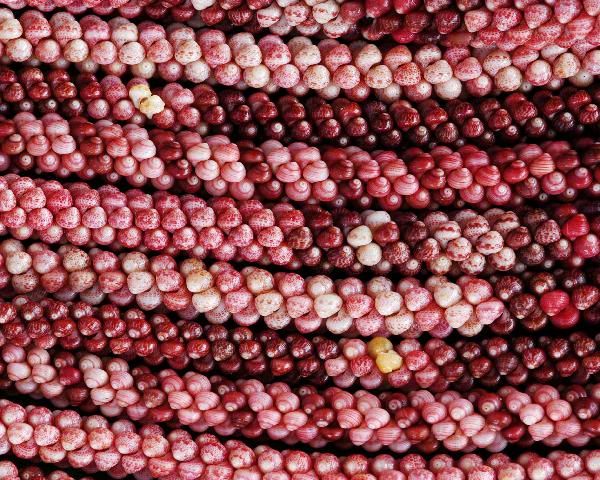 To give you an idea of how far back the Ni'ihau shell lei-making tradition goes here in Hawai'i - this is a picture of Queen Emma from the 1860's (Kamehameha IV's wife) wearing multi strands of Ni'ihau shells....  So......I find Ni'ihau and the people of Ni'ihau fascinating - they have a different outlook on life than most of us do I've found in my experience and love the island and what most of us would consider a very simple and uncomplicated life. However, they do also welcome improvements - for instance when the big box store Costco came to Kaua'i - we now have families who have ohana (family) on Ni'ihau coming in an buying very large amounts of food items to be shipped over on the barge that visits Ni'ihau once a week - and some of the ohana who travel back and forth like my friend Ehu - enjoy all the comforts of live here on Kaua'i (giant trucks, movies, and the beautiful Hawaiian church in Waimea that is filled with the sounds of Hawaiian hymns being sung in harmony every Sunday) - I consider myself very fortunate to have friends from Ni'ihau - they bring a whole new level of understanding the Hawaiian culture. I've also become somewhat "addicted" to the beautiful and rightfully expensive lei from Ni'ihau - I have 5 different lei and various bracelets and earrings - and I'm still gathering more - most from my friend Ehu and her ohana, but also from another friend of mine Kaleo Kaohelauli'i (try saying that fast!!) who works at the Museum 3 times a week demonstrating the making of these beautiful lei. The problem is, if I see him making a particularly tempting one - then I'm a goner! lol....here is a picture of him at the Museum working - the bracelet you see on his table ended up on my wrist!! 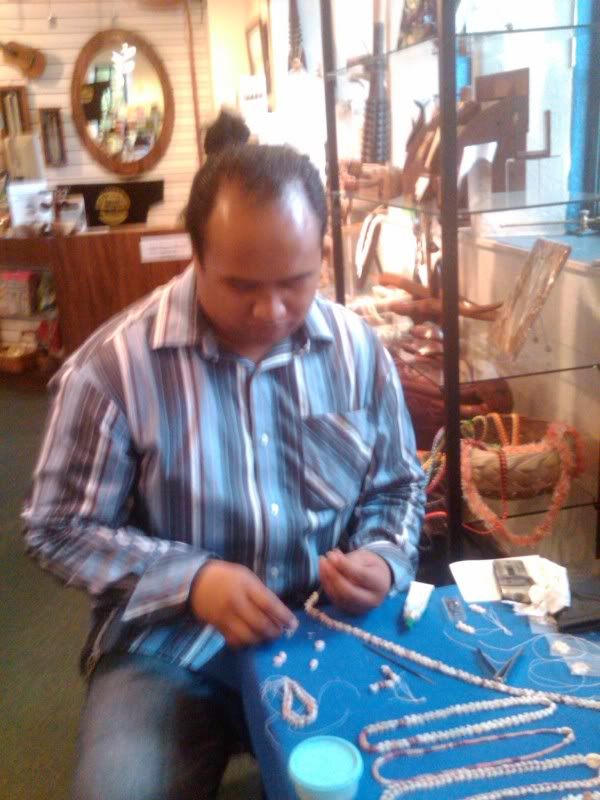 Malama Pono, Janet 
|
|
|
|
Post by auntieannie on Mar 19, 2011 10:32:23 GMT
ah, questions came to me about hula moves:
Would there be some moves that are particular to one Hawai'ian island?
If so, would the moves travel from island to island with inhabitants migration within the archipelago?
Hopefully my questions make sense.
|
|
|
|
Post by tod2 on Mar 19, 2011 11:08:18 GMT
Hi Janet! Not only am I excited to find out that your Taro vegetable is actually the exact same thing we grow and eat here in South Africa, but the Pandanus tree is also very common here and I actually have a very large one in my garden! The sad thing for me is I have only ever seen it flower and no fruit ever developed so I gues I have the 'male' tree. I in fact call it the 'penis' tree because the roots growing out of the trunk look exactly like a male penis.
|
|
|
|
Post by onlymark on Mar 19, 2011 12:57:10 GMT
Just out of interest, we have the same taro here in Egypt as well. Though it's not widely eaten.
|
|
|
|
Post by koloagirl on Mar 19, 2011 19:43:57 GMT
 Aloha from Kaua'i! Mahalo again for your interest - it is so fun to talk to people from all over the world who are interested in these little group of islands that I live on!!  As far as hula - there are songs (mele in Hawaiian) and chants (oli in Hawaiian) that are about each island and their gods, legends, flowers, etc. - there are certain hula "moves" that are named after a particular island (Moloka'i is one that I can think of off-hand) - but in general, they are common to all of the islands. Here are a few hula pictures - you just knew I had them, right? These are from the hula halau (school) that I belong to: Halau Hula 'O Leilani (the Kumu Hula, or hula teacher, is the lady in the blue dress shown in an earlier post) ---- This is a hula auana (modern hula) that we performed a couple of years ago: 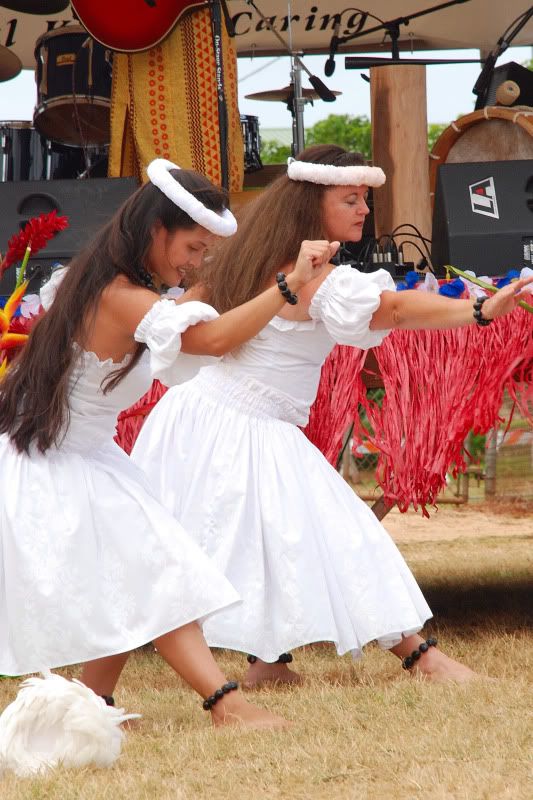 This is from a Christmas hula show we did a couple of years ago - hula auana (modern hula):  This is an outdoor performance we did at a local beach park - it was actually a Memorial service for a beloved musician of our halau - note Kumu Hula Leilani dancing in black - all of us in white costumes - hula auana again: 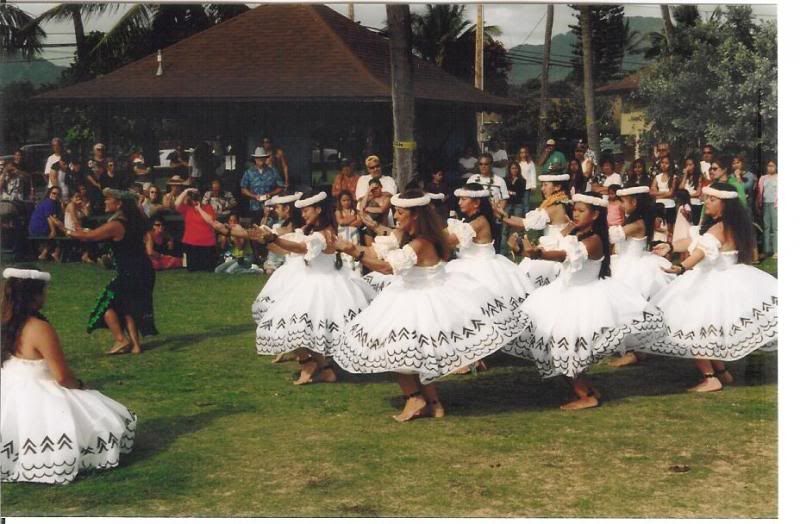 Another view of same dance - this was called "Ke Alaula" and means roughly "The Dawning" 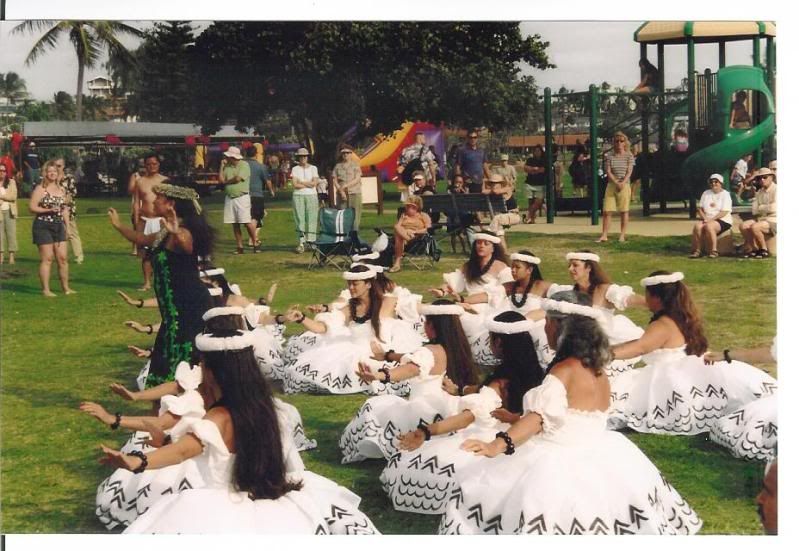 A picture of Kumu Hula Leilani dressed in traditional kihei (cloak) and adornments for hula kahiko (ancient hula) - doing a chant (oli) as the dancer performs outside above the ocean (this is the torchlighting ceremony at the Grand Hyatt Kaua'i that I work as narrator for: 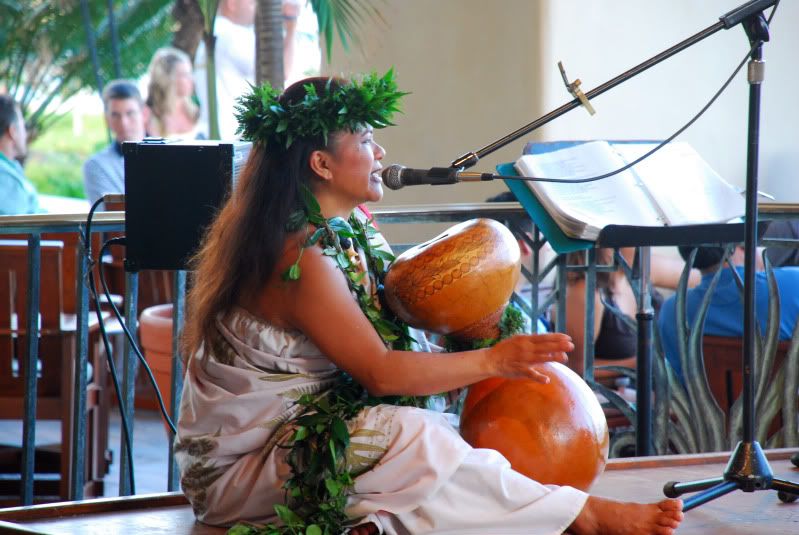 A picture of the dancer (olapa) being escorted by the torch bearers to her dance platform at the torchlighting ceremony for the hula kahiko - Grand Hyatt Kaua'i 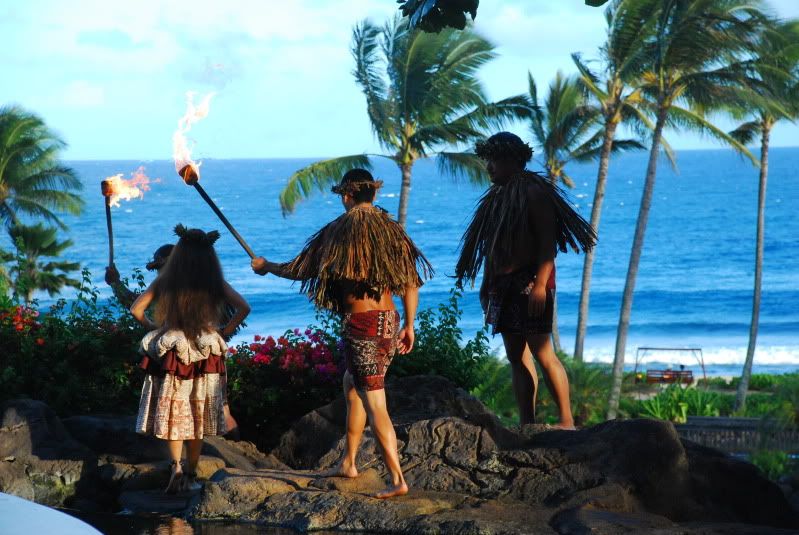 A night-time picture of the dancer at her platform - since we do this at the same time of year all year round - sometimes it is just at sunset, sometimes just after - this is obviously just after since it is so dark - for instance right now - very light and just before the sun goes down: 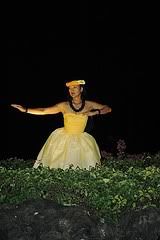 This is a picture from our annual Hula Ho'ike (show) that we do every year as a fund-raiser for our Hula Halau - this is a group of kaikamahina (young girls) dressed for a hula kahiko: 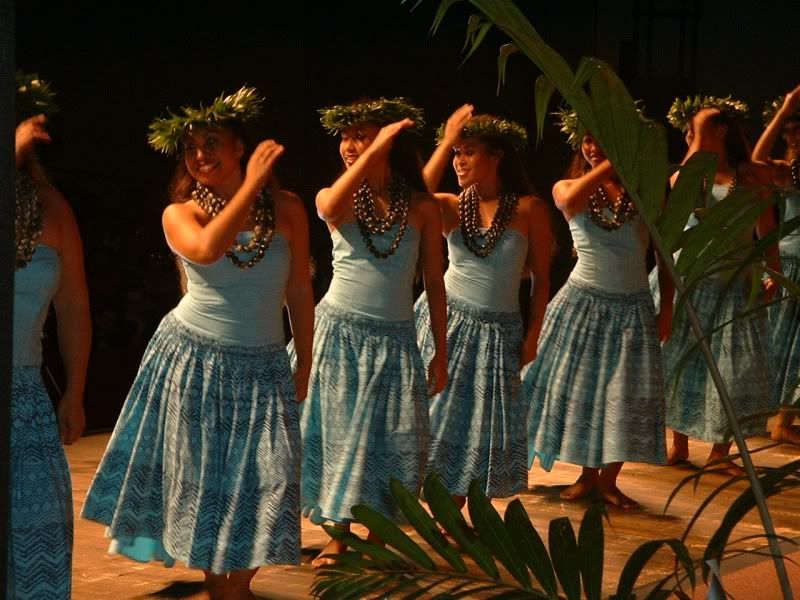 A picture of Leilani on a Japanese language hula magazine - Hula is VERY big in Japan and Leilani normally travels 3-4 times a year to teach hula workshops and do concerts there - she just cancelled a trip she was making there in 2 weeks due to the tsunami/nuclear disaster there in fact - I am glad she isn't going though! 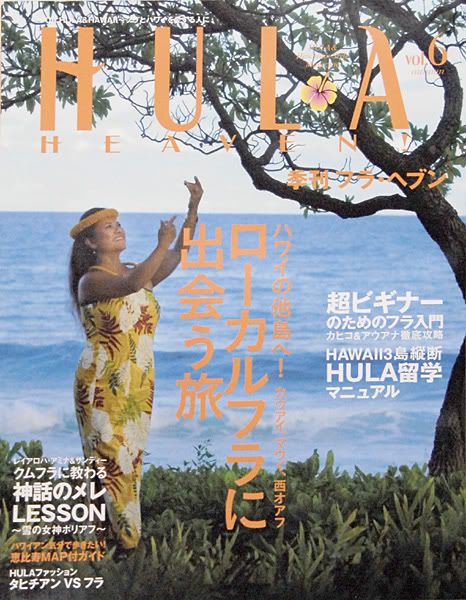 This is the back of her latest CD - I'm putting it on here so you can see the Ni'ihau shell lei (mine and hers together) that she wears, as well as the traditional maile lei - this is a sweet smelling vine that is gathered in the uplands here and woven into a lei..... 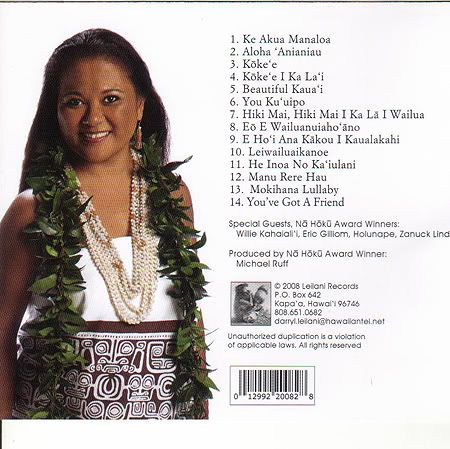 And - a picture from this year's Hula Ho'ike (February) that shows some of our keiki (children) performing a hula auana with a hula implement known as an 'uli 'uli - or feathered gourd (there are seeds in the bottom gourd that make a rattling noise when shaken) 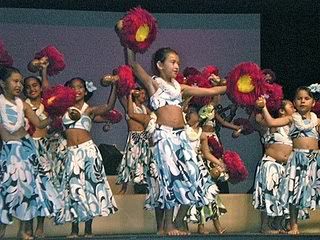 So many hula pictures - but since it is probably the single biggest part of my life here - I thought it would be important to share these pictures here with you - when you are in a hula halau - it isn't just "classes" - but you form friendships and bonds with your fellow students that make it an ohana (family) where everyone is very close to one another - my closest ohana all come from the hula halau I am with for instance. Hope this is of interest to any of you - I do tend to get a little carried away with hula topics!!  Malama Pono, Janet
|
|
|
|
Post by Deleted on Mar 19, 2011 21:27:36 GMT
Fantastic pictures, and the hula performances look a lot more sophisticated than the imagery of "dancing savages" that movies have tended to make us believe.
The costumes are somewhat surprising. While I do not really expect people in the 21st century to want to perform in grass skirts or banana leaves (and that is not really what I would want to see either), it does look like the dancers have been clothed with extreme missionary influence ("We need to cover you up, girl!"). Do you have any idea around around what time the traditional island clothes were ditched to conform to the more modest values? And has the indigenous population totally adopted the imported religion, or do they still honor the earlier deities?
|
|
|
|
Post by mich64 on Mar 19, 2011 22:21:32 GMT
The Christmas pageant picture is stunning, the colors are so brillant. I do love the descriptions also of the shell necklaces, they are gorgeous. I am learning so very many things from your posts and enjoying them very much.
Thank you Janet!
Cheers!
Mich
|
|
|
|
Post by Deleted on Mar 19, 2011 22:29:30 GMT
I have another question about Hawai'i. I know that the islands are not nearly as close together as one might imagine when looking at a map -- I know this from having visited Tahiti twice and having to take 'major' flights between some of the islands -- and of course Hawai'i is much bigger.
So I was wondering how much interaction there is among the islands and if people really feel extremely different depending on which island they live. Do people scorn "those Oahu people!" or whatever, or is there island solidarity when faced with those strange people from the big continent?
And of course, is Barack Obama considered to be a local or an outsider?
|
|
|
|
Post by bixaorellana on Mar 20, 2011 16:43:03 GMT
Oh, Janet ~~ the more you tell us and the more pictures you show, the more interesting this gets! Almost every picture I've ever seen of hula was more an excuse to show pretty girls than to convey any meaning. You are really helping to fill in the blanks. A question: can the group dances be performed by a single dancer, or is some meaning lost? One thing I find interesting is that the groups are not background dancers for a dancer or singer. Can I assume that says something lovely about the culture as a whole? Now I'm going to nag you again about the fabrics -- your fault for showing so many gorgeous examples! Maybe you're saving that for a separate thread.  Also, I'm directing your attention to this very abbreviated thread. It's abbreviated because no one knows anything about the topic: anyportinastorm.proboards.com/index.cgi?action=display&board=music&thread=4838&page=1#103840The clothes worn for hula are so varied, and it's interesting to see how the modern interpretations manage to suggest tradition. It must have taken forever to find and gather those perfect pink shells! How do you care for lei? They must be somewhat fragile. Are the shells like pearls, in the sense of needing special care? Thank you so much for this -- it's endlessly fascinating and beautiful. |
|
|
|
Post by koloagirl on Mar 20, 2011 22:28:26 GMT
;D Aloha from Kaua'i! First of all - pictures - and almost real-time, since I took them only about 4 hours ago - on one of the farthest West beaches on our island called Kekaha (if my pictures were clearer you could see Ni'ihau) - where on Sunday mornings before dawn my husband runs and I walk along the beach road - there was a "supermoon" last night and it was still up when we got there just before dawn today - so pictures of that - they are pale imitations of the real thing, which was amazing as it shone on the water! 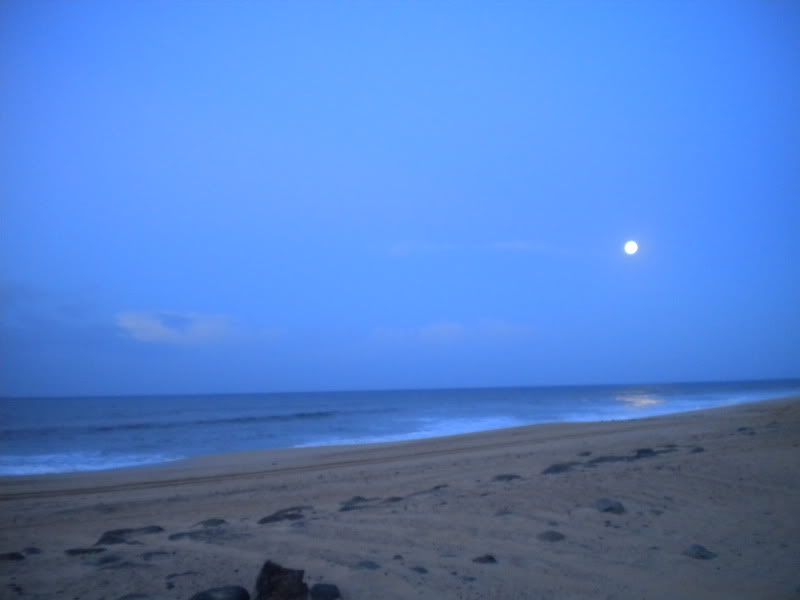 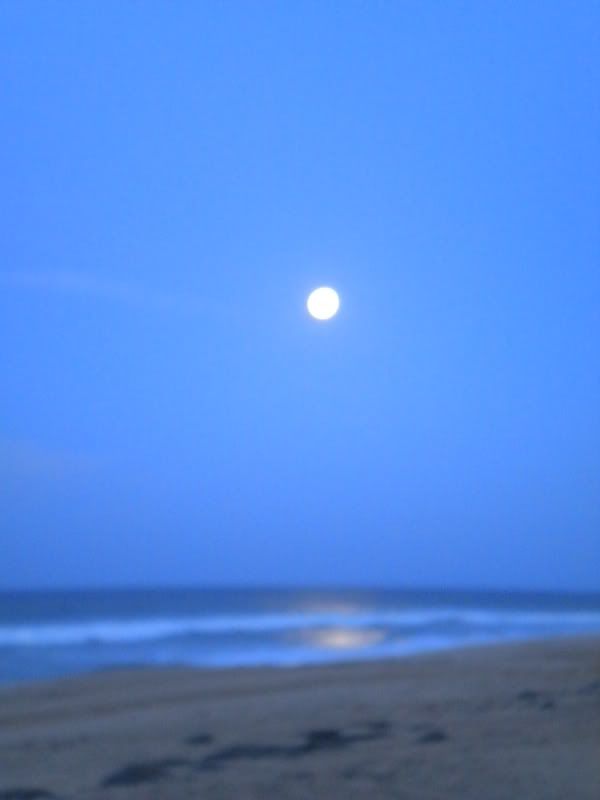 And looking towards the dawn in the opposite direction: 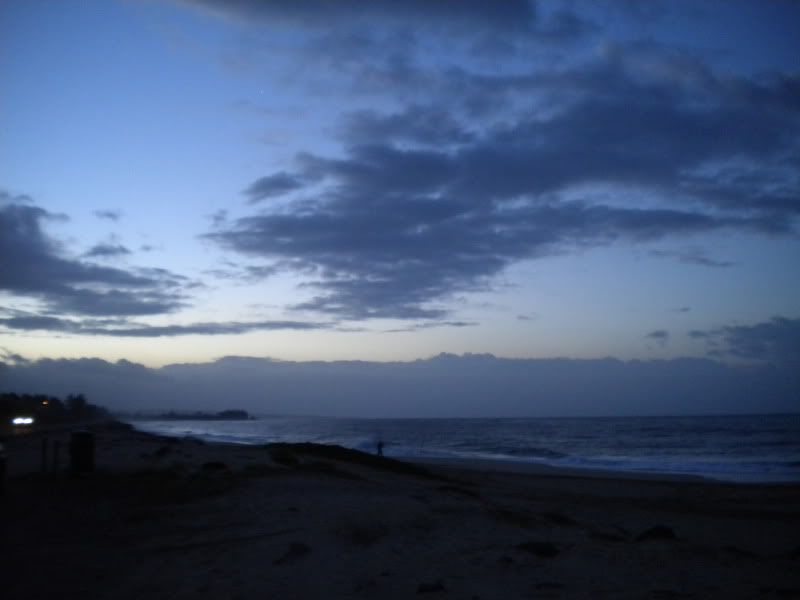 Mahalo once more for the great questions - I'm so amazed really that people are interested and ask so many wonderful questions - I'll do my best to answer.....I'm far from an "expert" however! "Kerouac2" - the islands are pretty close together - for instance, the flight from here to O'ahu (where Honolulu is) takes just about 20 minutes once you are in the air - hardly enough time for them to give you some juice and pick up the cups! The islands are all very distinct and different from one another and there is indeed a bit of "island pride" in your "own" island being better than the rest (in a not mean spirited way though - at least not usually!) - for instance, Kaua'i is thought to be pretty much of a hick town, rural and with not any shopping, nightlife or fine dining - and actually other than the "hick" part - that is pretty true! We are considered the most laid-back of the main islands (not counting Moloka'i and Lana'i, which are definitely more laid-back than we are!) - and my husband and I actually joke when we go to the "big city" of Honolulu and say that on the big highways there (which we don't have, we only have one highway that goes only part-way around the island, the Na Pali coastline is inaccessible and is a wilderness area, so you can only go so far around the island) have the signs that say "slow traffic keep right"? .....well, we think it should say "slow traffic and Kaua'i residents keep right!!!". We do definitely consider O'ahu the big city - the women are more glamorous, dress fancier (that wouldn't be hard to do, since I live most of the time in a pair of shorts and a t shirt!) - and crave all the big designer stuff - fine dining and all the "big city" type stuff (I love art and foreign films, and we have to go to O'ahu for those!)... that would be our perception of them - at least in my opinion! Oh, and they certainly have the night life and fine dining also - which we certainly don't! Maui - the stereotype is of a place that has become very popular with people from Southern California in particular - and so there are large areas of land there that look a lot like Southern California as people buy up land and create big golf course areas, shopping malls and high rises along the beach. But Maui is also beautiful and has some gorgeous rural areas that are among the most beautiful in the whole state - the Hana Highway is a windy stretch of road that hugs the ocean and goes thru a rain forest with tons of waterfalls and heavy foliage - just gorgeous!! Big Island - Hawai'i - everyone here calls the island of Hawai'i the Big Island - it is indeed BIG! And there are big resort areas with the types of resorts that have captive dolphins that you can pet and golf courses, etc. - but you also have the "upcountry" area of Waimea, which has the biggest cattle ranch in the United States - Parker Ranch. The Volcano National Park is spectacular and a very spiritual place for the Hawaiian people - as the fire goddess Pele resides in the crater of Halema'uma'u....Kilauea crater has been active for many, many years now and puts on big displays of flowing lava and shooting lava (I've never seen this actually, I've only been there when things were quiet!) which is very popular and the whole area there is one of the best places in the world to study active volcanos. There is also an area called Hilo, which reminds me a lot of Kaua'i - in fact I always say that if someone put a gun to my head and said I had to re-locate somewhere else in the state - I'd choose Hilo. Small town, a lot of older buildings, quaint and quiet and also the home to the "Super Bowl" of Hula called the Merrie Monarch Festival - which happens next month. It is a 3 night event in which hula halaus from all over the state (and the mainland) compete and it is broadcast here on TV live all 3 nites - it is the premiere event in hula and Hilo reflects that with lots of shops dedicated to Hawaiian designs and culture. I have been to Moloka'i - which is truly a very Hawaiian island - it is small, very, very rural with only one town called Kaunakakai (the only bank, post office, market, etc. are all here) - and it has amazing beauty - the Leper Colony of Kalaupapa (in the 1800's, people with leprosy in the state were forced into a remote colony on this small island, horrible conditions existed until Father Damien came and ministered to the people of Kalaupapa - he contracted the disease finally and died from it - he was just made a Catholic Saint last year) is on a remote peninsula and while very remote, is gorgeous and wild. There are many ancient fishponds that used to be found in abundance on all the islands, (we have one here on Kaua'i in good condition) that dot their coastline and Moloka'i also vies with Kaua'i for being the "birthplace" of hula - long, long story there - legends galore. Barack Obama - the vast majority of people here embrace him as a "local" and definitely not an outsider....he went to a very prestigious high school called Punahou on O'ahu and still has family there....he goes to O'ahu for vacation quite a bit and all of us love the fact that he is one President who can correctly pronounce all the various place names here in Hawai'i as well! lol There are tons of bobble head dolls of him dressed in an aloha shirt in the souvenir shops - tres tacky! When he comes to Hawai'i, he always goes to a favorite shave ice place as well (shave ice is a uniquely Hawai'i thing, it is actually "shaved" ice in a cup with flavored syrup poured over it)...and he does body surf.  Getting back to hula questions: any song can be done by either a group or a solo dancer - each Kumu Hula (hula teacher) choreographs the dances based on her mana'o (thoughts) about the song and the meaning in it - it doesn't matter if it is danced by one individual or a group. Many musicans here as well as musical groups use either local hula halau or dancers in their performances also (our halau for instance performs quite a bit with the Makaha Sons, a very popular group)......but it isn't required. Hula comes from the heart and the quote "hula is the heart of the Hawaiian people" is a very popular and apt one. As far as costumes - there are certain guidelines for hula kahiko (ancient hula) In one the first pictures I posted, there is a small group of us in dried ti-leaf skirts and lei po'o (head lei) - with kupe'e -which are "bracelets" of some type (either shell, nut, or other material) that are worn on the wrists and ankles - also the costumes in the white that I showed? Those are also hula kahiko costumes, but they can be used for hula auana as well if the adornments are changed. Kind of complicated I know! As far as the missionary influence - well, costumes these days for modern hula can pretty much be anything - I've seen kane (men) dance in surf shorts and aloha shirts - women can be in anything from the short green ti-leaf skirts with the bloomers and tops (kind of a more old fashioned look) to glamorous gowns that sweep the ground and billow when you dance. For instance, the blue and white dress I'm wearing in the one picture? That is my newest costume that we just used this February for our annual Ho'ike (show) - it was designed by our Kumu Hula and our halau seamstress. The material is a soft type - almost like a batik (I don't know fabrics, sorry!)...and the skirt is huge...really huge....when you hold it out on each side, you look like a big butterfly! So, I don't think that modern hula really has a lot of "rules" these days for costumes - but ancient hula should reflect somewhat at least the period of time before Western contact. There was a trend a few years ago to dance topless in just the ti-leaf skirts and to either tape or glue the maile lei (the green leafy vine lei) on your bare breasts....it kind of was a fad that came and went. This actually had more to do with the very popular photos of a local photographer named Kim Taylor Reece who did "art photos" of hula showing gorgeous women and men in hula poses and wearing very little than it did with "tradition":  In the late 1800's, hula made a revival - the missionaries had banned it, but it never went away - it just went "underground" and people studied it in secret. When hula came back, you could certainly see the missionary influence in the dress (check out the striped stockings!!): 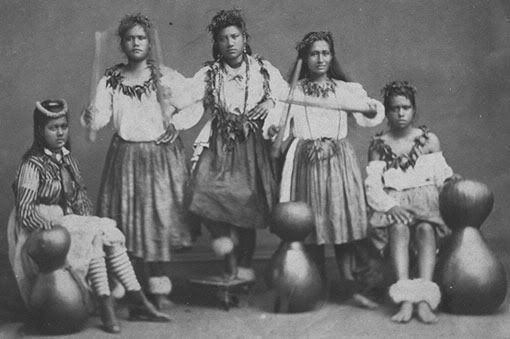 Now you very seldom see that bare-breasted look at traditional hula halaus (maybe at some commercial lu'aus though) - and actually some of the earliest prints that Westerners made of dancers from Hawai'i actually show women either draped in a fabric type top made out of tapa (kapa in Hawaiian) or bare-breasted - so to dance with a top on is not necessarily something that just happened after the Missionaries. This is a really old picture of the hula halau that Leilani and I started in Reno - performing a hula kahiko - you can see a hau skirt (a type of raffia) that is also used sometimes in hula kahiko, as well as the kupe'e - which in this case are shredded satin made into lei (this is SO time-consuming, as is making the skirt, which is made one strand at a time). 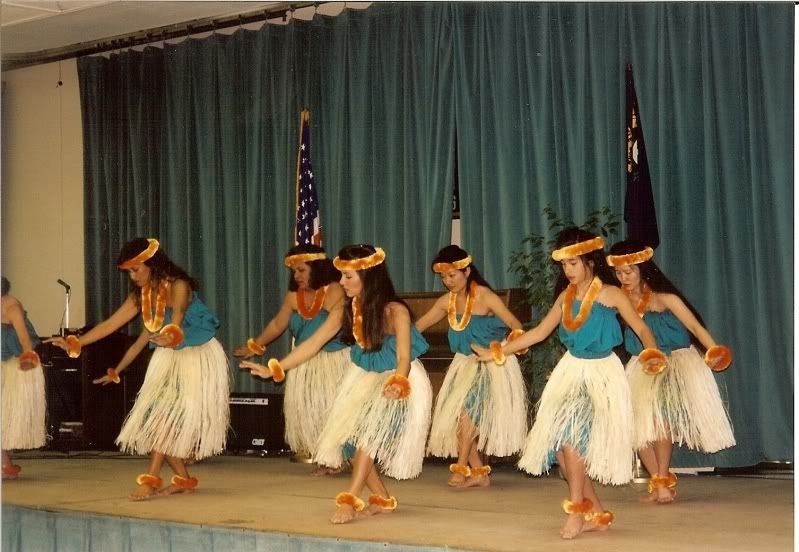 Sorry for being so long-winded here - I hope I've answered most of the questions - I tend to lose track after awhile!  Please ask away if you think of anything else - I obviously love talking about my adopted culture and home! ;D Malama Pono (take care), Janet |
|
|
|
Post by koloagirl on Mar 20, 2011 22:38:59 GMT
;D Aloha from Kaua'i! I forgot to answer this question: "And has the indigenous population totally adopted the imported religion, or do they still honor the earlier deities" The vast majority of people here (and I mean VAST) do not honor the earlier dieties in terms of praying to them as Gods - but for instance in hula, we honor the ancient gods in chant and dance - and my Kumu Hula, who is catholic for instance - does not do some of the more ancient rituals having to do with hula (the ancient ceremony called 'Uniki, in which students "graduate" in an ancient ritual (one public, and one private) that honors the hula goddess Laka and deals with ceremonies where you pray and give offerings to the goddess...etc. There are many hula halaus that still do this, and who still honor the Christian faith in addition to honoring the "old gods". I think most people here feel that the "old gods" had to do with nature and so there are many ways to honor them - but not "worship" them - if that makes any sense. There are also unfortunately a few caucasian (haole) people who have embraced kind of a New Age type teaching that incorporates some aspects of the Kahuna (priests) of ancient Hawai'i - they mix this in a big pot with all the other New Agey stuff - and you can find them in the yellow pages under people who will do Hawaiian blessings, weddings, ceremonies, etc. - the REAL practitioners of any type of spiritual practices here - are very low-key and do not make themselves widely known. Anyway, just an interesting thing, as you'll see a blond woman with a fake floral lei and a cape that says she does "authentic Hawaiian spiritual practices" - for a price! LOL Nutters can be found anywhere!  Malama Pono, Janet |
|
|
|
Post by bixaorellana on Mar 20, 2011 22:52:50 GMT
Oh ~~ please, please never apologize for your very complete and completely interesting comments and answers! In your very first thread, you have truly caught the spirit of what Anyport is about -- showing the rest of the world your vision of whatever in the world interests you. there were two very famous Hawaiian musicians flown in from Honolulu who played music well into the night - almost everyone got up and did hula Can most people who are from Hawai'i do hula at least a little, or was everyone doing it at that party because they are from Ni'ihau? |
|
|
|
Post by auntieannie on Mar 21, 2011 12:42:03 GMT
apart from the farms on the big island are there industries that are not totally linked to the tourism industry in Hawaii?
I come from a touristic region myself, so know it is difficult.
Are there lots of hawaiian people who move to mainland USA for studies and work? If so, do they prefer one particular area of the country? Do they keep the bonds with others who have moved away?
|
|
|
|
Post by koloagirl on Mar 22, 2011 20:01:11 GMT
;D Aloha from Kaua'i! A couple of questions that I missed answering the other day - oops! The care of a Ni'ihau Shell Lei - they are not all that fragile surprisingly - but you have to take care not to spray hair spray or perfume on when you are wearing them (just like any other fine jewelry) - and as far as keeping them - you wrap them in a piece of flannel and keep them in a box - also, to clean them you just use a soft, damp cloth and water - also you can use baby oil lightly to shine them. "Can most people who are from Hawai'i do hula....." ----- no, definitely not, although the percentage of children who at some point in their lives actually take hula is very high, and a large majority of women in particular, have taken hula at some point. Hula actually is defined as "dance" in 'Olelo Hawai'i (Hawaiian Language) - so to say for instance "I dance hula" is redundant - it is like saying "I dance, dance". Something that you might find interesting is that there is a traditional "May Day" here in Hawai'i - this was actually created by the Hawai'i Visitors Bureau in the 1900's (May Day is Lei Day in Hawai'i Nei) - but it has become so embraced that is now is really traditional. What it means is that May 1st is a day where you are supposed to give a lei to friends, family, etc. - also every school in the state has a May Day program - which consists of the children (elementary school and high school) learning a hula to perform for parents and friends on that day - as well as having a "Royal Court" - where they elect a May Day Queen and King and Princesses - who normally do a solo hula and who wear specially designed dresses, garments with matching lei. May Day programs at the schools can be held anywhere from the 1st of May until the end of the month. Here are a few pictures of May Day programs and their Royal Courts: 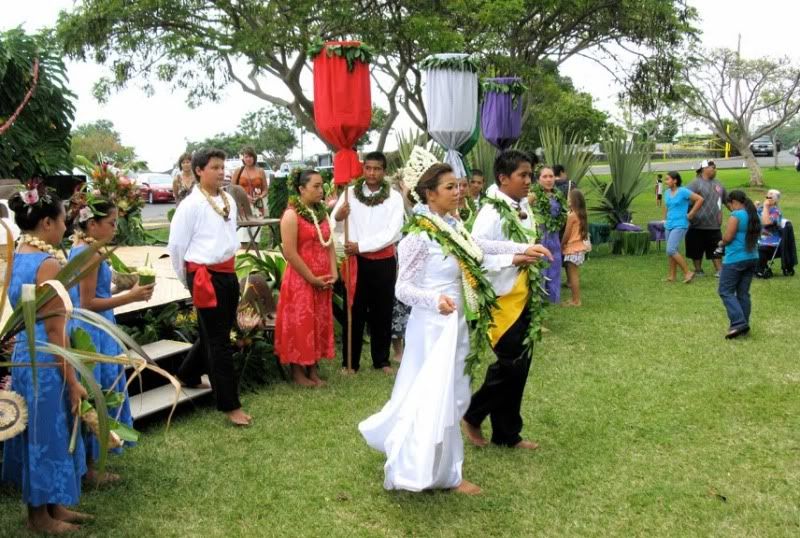 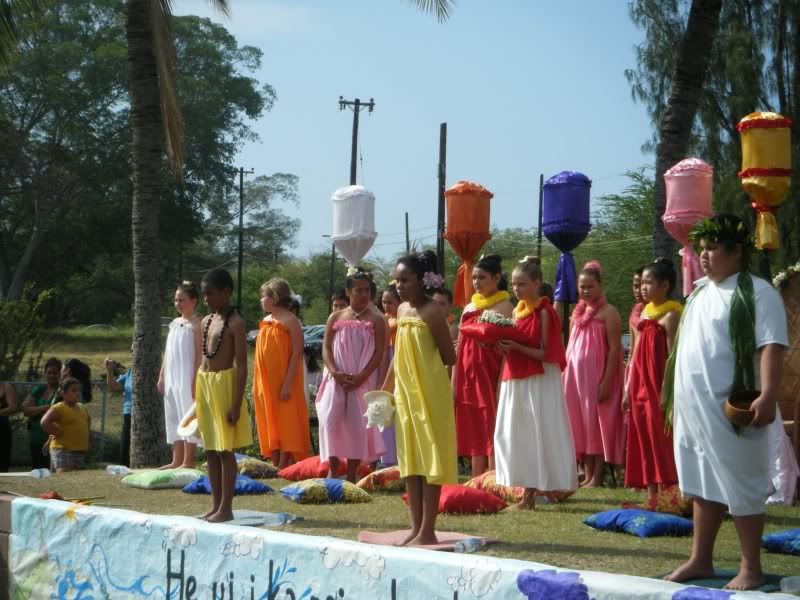 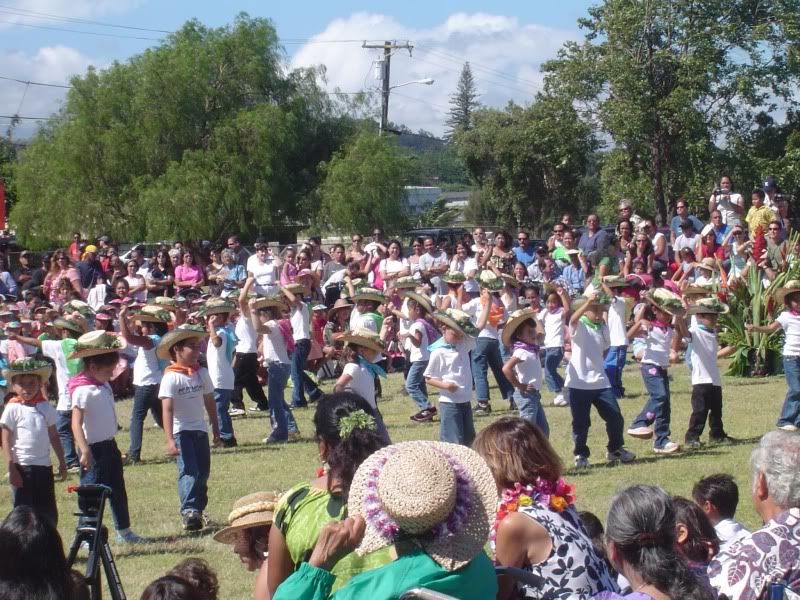 Something you might also wonder about are the large "standards" being held by the members of the court flanking the King and Queen - these are traditional symbols of Hawaiian royalty and are called "kahili" - they can be anything from the very large ones you see in some of these pictures to smaller hand-held ones and traditionally they are made from feathers - they would be carried by courtiers who followed the Hawaiian Royalty and held these standards over their heads or walked behind them carrying them - this is a traditional Hawaiian feather-art that is still taught today. In fact, at the Kaua'i Museum where I volunteer, there was a workshop taught by a Kumu (teacher) in these feather arts - many of the workers at the Museum made one of the hand-held kahili. Now, I am known for being absolutely hopeless with any type of "crafts" - I usually have to rely on the kokua (help) of my hula sisters to make some of my adornments that are a little more difficult - I can make a pa'u la'i (ti leaf skirt) and the shredded satin lei - but I never thought I'd be able to make one of these kahili. Well, so many of my fellow workers at the Museum were doing this workshop that they really kind of "pushed me" to try it - and I am very glad I did - because here is the final product: ![]() img.photobucket.com/albums/v202/Koloagirl/My%20life%20on%20Kauai/DSCN1767.jpg img.photobucket.com/albums/v202/Koloagirl/My%20life%20on%20Kauai/DSCN1767.jpg[/img]  I was told by the Kumu that you should always "name" your kahili with a Hawaiian name that has some meaning to you - so I ended up naming (with assistance from my Kumu in Hawaiian Language) my kahili "proud black flower" or "kapuaele'eleha'aheo" in Hawaiian.  Kahili are beautiful and I really am still nursing a sore arm from "patting myself on the back" after I managed to make this. It was very, very time consuming. You would take 2 feathers (rooster feathers) and then wire them onto a toothpick, them putting floral tape around it also. You made about 200 of these little feather "bundles" and then you slowly started to put them on the stick in a graduating pattern down the pole, using floral tape and then finishing it off with satin cord and ribbon. I actually have enough to make one more kahili this size - so I really need to start my "bundling" because that is the time consuming part! Kala mai (sorry) because I got off track the questions here! As far as the industries that are not related to tourism here in the state? Honestly, there are a few, but they are very small indeed compared to tourism - which is our No. 1 industry. Kaua'i has flowers, coffee, and other things that they export, and there are a fair number of the somewhat controversial GMO (genetically modified organisms) crops being grown here as well - lots of seed corn, etc. GMO is controversial and the attempt to make a type of taro (kalo) that is GMO is seen to be not sensitive to the Hawaiian culture, which regards kalo as a relative to man - due to its role in the "Kumulipo" - or creation chant that ancient Hawaiians had - kalo was actually the first "man" in this chant. Here are pictures of some museum-quality kahili to give you an idea of what they can look like: An exhibit of kahili from the 19th century: 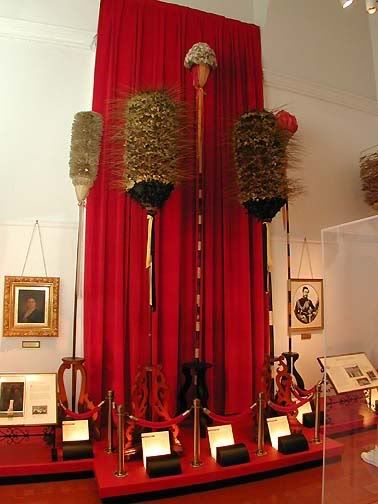 This is a photograph of Princess Ka'iulani at a banquet - you can tell who she is by the hand-held kahili being held behind her: 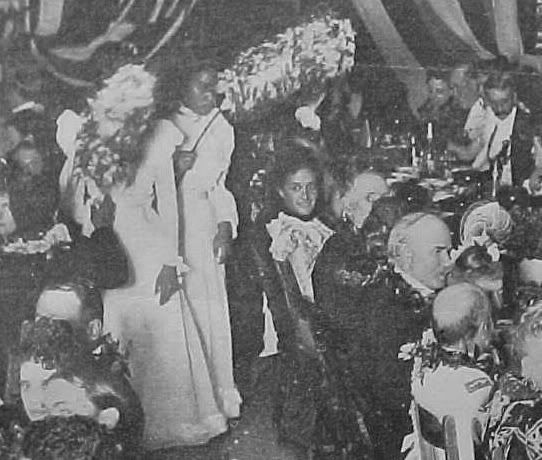 In this picture of Queen Emma's funeral procession, you can see the large kahli standards being carried in the procession: 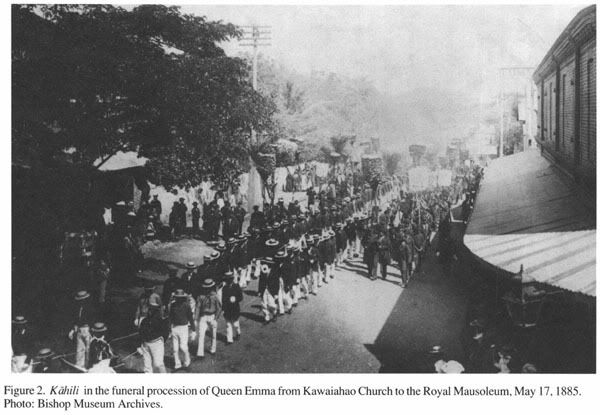 So.....once more, mahalo for your questions and please ask away if you have any more!!! Malama Pono, Janet |
|
|
|
Post by Deleted on Mar 22, 2011 20:11:42 GMT
The kahili would be very popular with chimney sweeps in Europe!  Just kidding!  I like the idea of the lei tradition on May Day. Even though it is more importantly international Labor Day in Europe and most of the world, flowers are an important part of it in France, and you will see hundreds of people selling bouquets of lily of the valley on every Paris street corner on May Day. Giving it to someone ensures good luck for the rest of the year, and the absolutely most important people to give it to are your mother and grandmother. At my mother's nursing home, the city of Paris ensures that every resident receives these flowers even if they have no family. |
|
|
|
Post by koloagirl on Mar 22, 2011 23:38:05 GMT
;D Aloha from Kaua'i! That is charming "Kerouac2" that lily of the valley is given on May Day! I had no idea of that - what a lovely tradition. I absolutely love flowers and when we went to Paris last year I was just agog at the florists there - with such amazing displays of gorgeous blooms! One of the first things I did when we arrived there was to go to a florist and buy a bunch of narcissus type flowers for the flat where we were staying - the care and detail the florist went to in wrapping this very small bouquet was amazing and impressed me very much! I can't wait to see what awaits me this September!! I'm also lucky because we have many year round type flowers here in Hawai'i - the ginger family in particular blooms year round - the plumeria (also known in some places as frangipani) are just now starting to come back from their dormant season. Here are some pictures of some of my favorite local flowers here (many of which you'll recognize under different names from other parts of the world!): Plumeria (comes in many, many color variations): 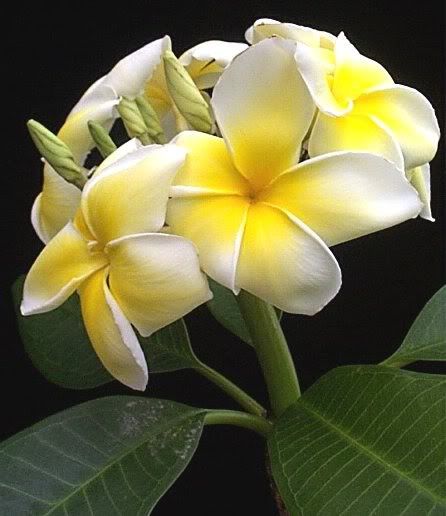 Torch ginger: 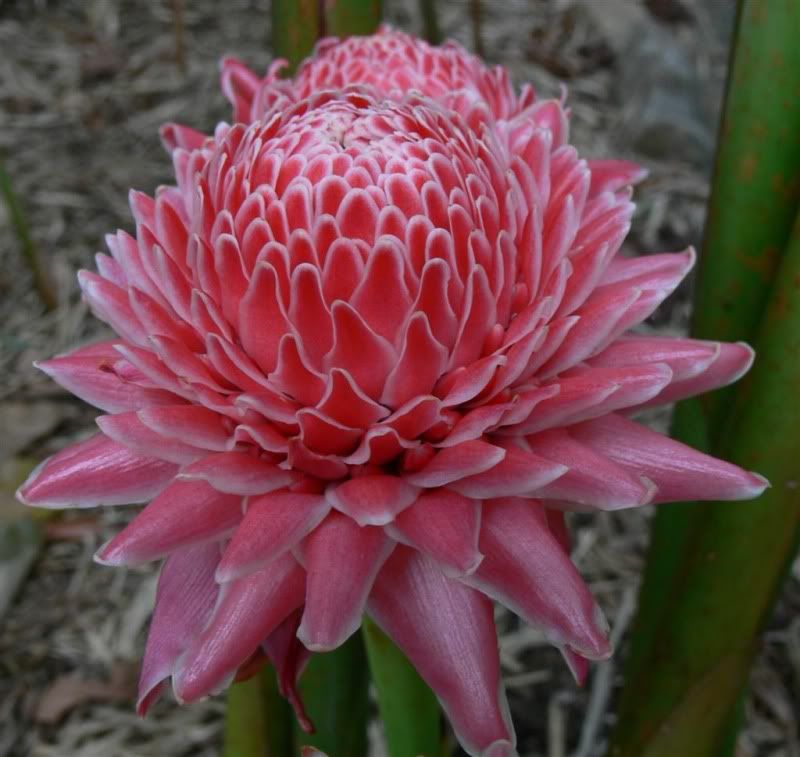 Tahitian shell ginger: 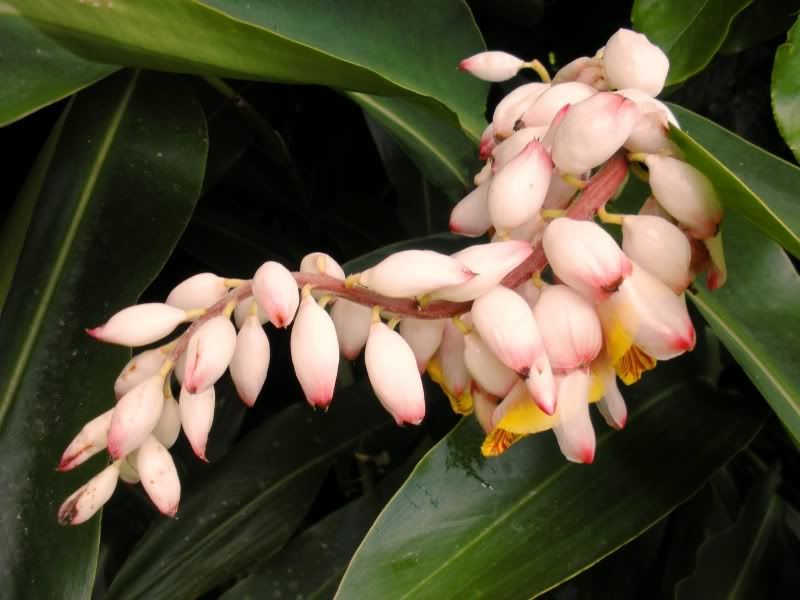 Helconia: 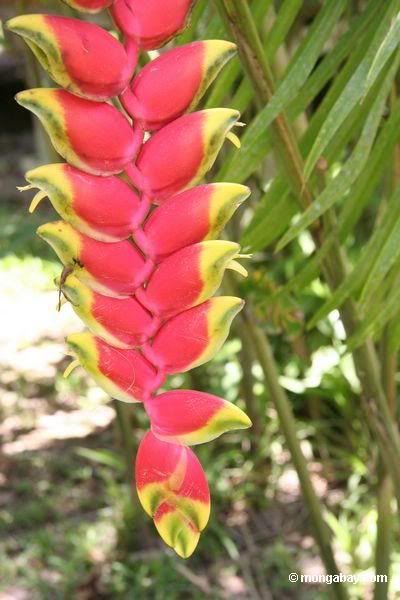 Tiare (tahitian gardenia): 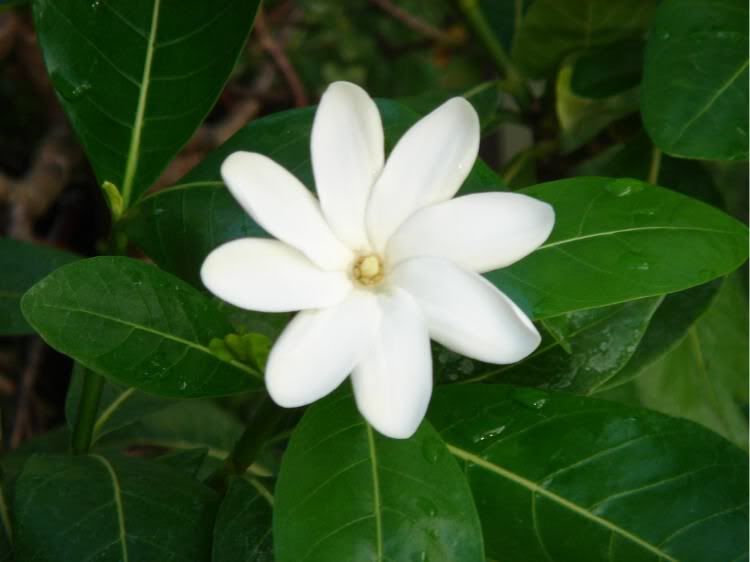 Pikake (also known as jasmine): 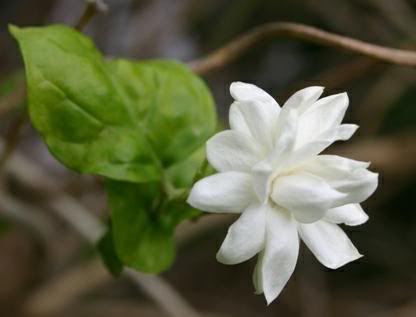 Right now there are some strains of plumeria that bloom during the winter, but the "hardier" strains that are used in lei making are just now coming back in season. Also "pikake" is very hard to grow here on Kaua'i, and pikake lei are very sought after and popular - but you almost have to go to O'ahu to get them - and only during the spring/summer months. The tiare are pretty common here and I know they are blooming, I just picked some yesterday and left them in my car to get that wonderful scent! All of the others that I posted pictures of are strains of ginger and they are around now - I have a big bouquet of red and pink ginger right now in my living room - it was $5.00 a bunch at my local "honor stand" (see earlier posts!). Malama Pono, Janet |
|
|
|
Post by Deleted on Mar 24, 2011 22:01:10 GMT
Janet, have you been to other parts of Polynesia to compare with Hawai'i? Obviously, I recognize a lot of the lifestyle from what on saw on my trips to Tahiti, but the "colonial" influence has understandably created a certain number of big differences. One thing that got me about Tahiti was that traditional French baguettes are a staple food item, but you have a grand total of maybe 2 hours to eat them crusty as they should be, and at all other times you have to eat them mushy in the humidity.  |
|
|
|
Post by koloagirl on Mar 25, 2011 4:53:58 GMT
;D Aloha from Kaua'i! Yes, I've been fortunate enough to travel to Tahiti 3 times - all to the island of Mo'orea - and we stayed at a traditional "fare" that was right on the water - no a/c, no window screens (the windows closed with a stick) - very basic, but absolutely fabulous! There are a great deal of cultural similarities between Hawai'i and Tahiti - which isn't surprising since the 2nd wave of migration to Hawai'i was from Tahiti (the first was from Micronesia) - so our languages are similar ("kane" for man in Hawai'i --- "tane" for man in Tahitian and so on...) and many other similarities such as the same flora and fauna as well - the same flowers they have in Tahiti are found here in Hawai'i and the climate is slightly different because Tahiti is closer to the equator than we are - but still pretty similar. I loved the baguettes in Tahiti - we would walk down the street to the Chinese market every morning and buy a baguette and put it on the bike and take it back home - it was by far the least expensive food item you could buy - and we loved it! As you say, they do have a difference in texture due from the wonderful baguettes in Paris due to the humidity factor. I've loved visiting Tahiti partly because it is an easy flight from here (5 hours and same time zone) and also because it is different (the French influence, which I love!!) but still very similar to our home. Our choice of vacation this year was to either go back to Tahiti - or back to Paris - and I don't need to tell you "Kerouac2" which one we chose!!!  Malama Pono, Janet |
|
|
|
Post by Kimby on Mar 25, 2011 19:18:20 GMT
This is a fabulous view into a place and a culture, with lots of local color. I'm so glad I clicked on the name of Any Port's newest member and found this thread. Kudos, koloa girl.
(I hope you don't mind if I put a link to this thread in the Local Color thread on the Waterfront Park/coffeeklatch board.)
|
|
|
|
Post by koloagirl on Mar 30, 2011 17:18:30 GMT
;D Aloha from Kaua'i! Well, up early (It is just after 7am here) and I've had my coffee and getting ready to go for my 2 mile walk and then exercise class in a local pool here (I'm gearing up for a 10 mile race/walk in Paris in September...got to get those miles in!!) -- so I'm not going to post pictures until I get home - but Yesterday I happened to think of the wonderful "walk around Paris" type pictures that "Kerouac2" and others post - so I happened to be coming back from our main town of Lihu'e and giving tours to 4th graders at the Kaua'i Museum - so, I kept stopping on the side of the road to take some snaps and then all the way to my home - so I'll get those downloaded to Photoshop today and do a "this is my part of the island" type thing - kind of like "walk around my arrondissement" - LOL! Just as soon as I come home and dry off - we've had lovely weather this week and I'm a sun kind of gal, so I do tend to stay at the pool and catch a few rays (I know, not good for me...but it feels so good!) after exercise. But my afternoon project it to put that together here! And no, of course I don't mind if you put a link in the "Local Color" thread - I'm honored!!  Until later....... Malama Pono, Janet |
|
|
|
Post by Deleted on Mar 30, 2011 17:31:20 GMT
I can't wait to walk around your arrondissement in photos, koloagirl! You know we want to see the supermarket and everything.  |
|































































